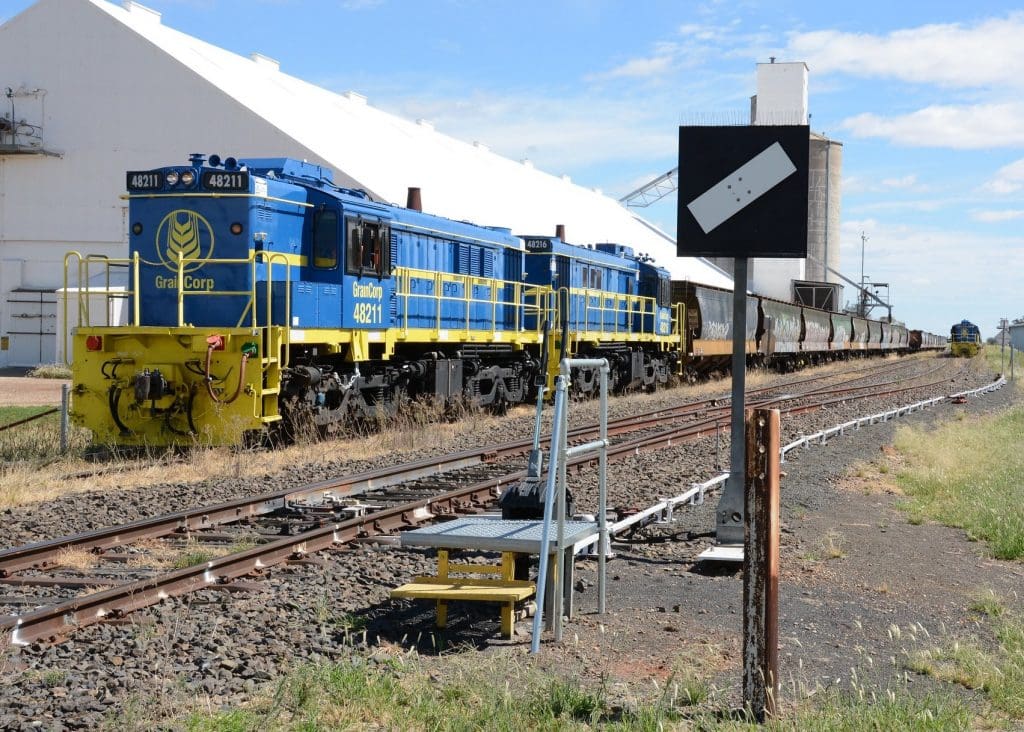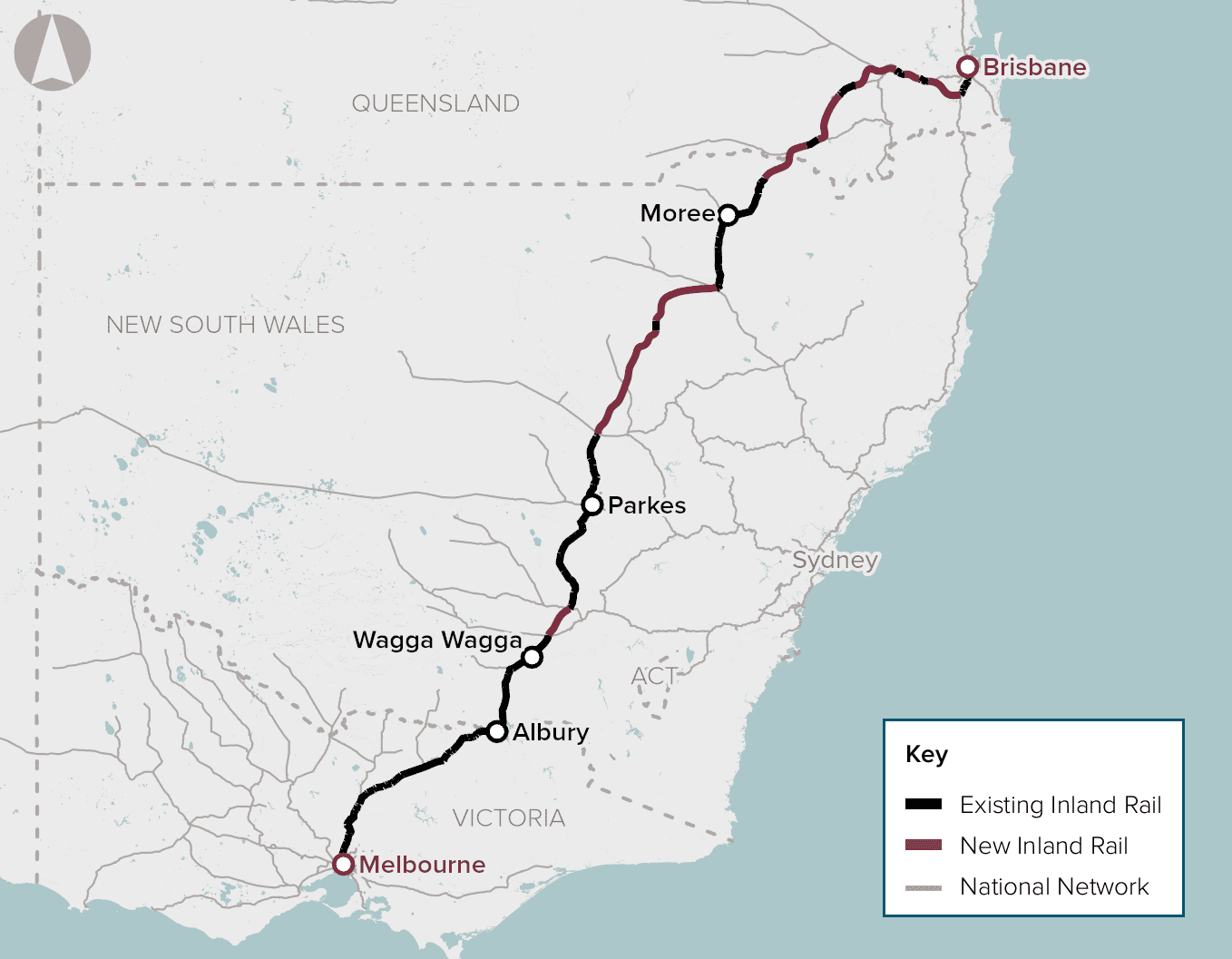
Operations on the Moree-Narrabri North line at sites including Edgeroi will be affected by Inland Rail works next year. Photo: Rob Astley
AUSTRALIAN Rail Track Corporation (ARTC) is in discussions with stakeholders to find ways to keep grain flowing around disruptions to the Moree-Narrabri North rail line in north west New South Wales next year while work on the Inland Rail project takes place.
The 101-kilometre section is an artery from the Moree Plains to grain exporters and domestic users in good crop years, and supplies feedgrain from the south in drought years.
Unofficial estimates say Inland Rail works could add $15-$20 per tonne to the cost of transporting grain on a line which can easily carry more than 1 million tonnes per annum.

Inland Rail route
The line is currently used by three rail operators — Aurizon, Pacific National and Southern Shorthaul Railroad (SSR) — and seven bulk grain handlers.
Following initial consultation with ARTC this week, SSR director Jason Ferguson is pulling together stakeholder ideas about the logistics task and the cost of keeping grain flowing when the northern part of the line closes.
“At this stage, from the second quarter of next year, ARTC plans to close the line north of Penney’s Road to Moree to allow Inland Rail upgrading work to continue, and all stakeholders agree that this section must be reopened before the 2021-22 harvest rail transport task commences,” he said.
This closure will potentially impact CHS Broadbent, GrainCorp, LDC and Manildra Group operations at Moree, and Boolah at Milguy.
“This closure is going to increase the costs for those sites north of Penney’s Road, and this will ultimately impact what farmers in that region receive for their grain.
“I am pushing for these increased costs to be covered by Inland Rail in some way so that farmers are no worse off.”
Requirement for road
Mr Ferguson said grain from the Moree and district receival sites would have to be trucked south, probably to train-loading facilities at the Grainflow site at Penney’s Road, Bellata, and to Narrabri.
“The road transport cost for this and the through-putting cost at these facilities further south needs to be met by Inland Rail so that farmers are not financially impacted.”
Mr Ferguson said he expected there to be around 12 train sets working in the north-west of NSW for the upcoming harvest task.
These carry mostly bulk wheat and some barley, as well as containerised cotton and chickpeas, and after three years of minimal production because of drought, the region is expecting a big winter-crop harvest this year.
The line works could start as early as April, and this is expected to see a hectic rail transport period from harvest this year to 31 March, 2021.
“For this to work efficiently once the planned closure occurs… it is going to be critical for the main facilities from Penney’s Road through to Narrabri and across to Walgett and Merrywinebone be in a position to load a train each day and also be able to load at night.
“We also need to look at what minor improvements may need to be made at some of those loading sites so that this can be achieved.”
NSW Farmers Inland Rail taskforce chair and Coonamble farmer Adrian Lyons said he understood ARTC would foot the increased cost of transporting grain while the Moree-Narrabri line was being worked on.
“I asked ARTC if it would compensate farmers if there was a delay into harvest, and they said ‘yes we will’, and we said we want to be kept up to date if there’s going to be a delay.”
Grain Central understands ARTC will be replacing rails, sleepers and foundations to increase wagon the line’s weight limit, and that next year’s works will stop at the end of October and resume in April 2022 so as not to disrupt grain movements during the main new-crop slot of November-March.
ARTC response
In a statement provided to Grain Central, an ARTC spokesperson said the company worked closely with industry and other key stakeholders on scheduling rail maintenance and enhancement works which were delivered regularly across its network.
“ARTC is mindful that there will need to be a balance struck between delivering construction on-time and within budget while also taking into the account the needs of current users on the Narrabri to North Star project section.
“With these considerations in mind, ARTC has developed a construction schedule allowing works on the Narrabri North-to-Moree section to be undertaken outside harvest season.
“ARTC continues to work with all stakeholders on the existing network, such as grain growers and train operators, to assess the impact to their operations and appropriate mitigations.”
Parkes-Narromine closed
Mr Ferguson said rail operators including SSR had not been able to use the Parkes-Narromine rail line for 16 months, and it looked like its closure would be five months longer than ARTC initially estimated due to ongoing Inland Rail works.
Grain Central understands this means road trains carrying copper concentrate from the Northparkes mine are taking containers to Goobang Junction near Parkes instead of loading at nearby Goonumbla to begin the rail journey to Port Kembla for export.
Mr Ferguson said the freight task for grain travelling north has also been impacted by the extended closure of Parkes-Narromine, with grain trains heading north for the drought market having to swing east at considerable cost.
He said his business had incurred an additional $300,000 of costs due to having to take feedgrain trains the longer and steeper route from Parkes to Dubbo via Orange.
Grain Central: Get our free daily cropping news straight to your inbox – Click here

HAVE YOUR SAY